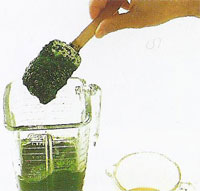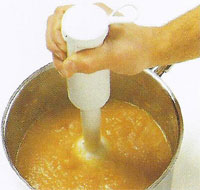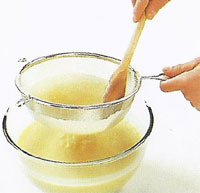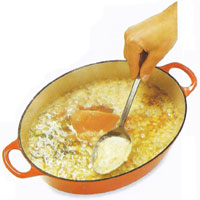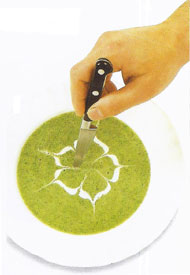SOUPS KNOW-HOW
HOMEMADE SOUPS are highly nutritious and wonderfully versatile. They may be simple
and quick to prepare or cooked gently and slowly to extract maximum flavor from
the ingredients. They may be hot and warming or cold and refreshing, light and delicate
or rich and hearty. There are even sweet and fruity soups. First-course soups should
stimulate the appetite and not be too filling. Pureed vegetable soups are ideal
as first courses, as are clear soups, particularly those with attractive garnishes.
Main-course soups are designed to be sustaining, and they normally contain ingredients
such as meat, poultry, fish, legumes, and pasta. Some good bread is usually the
only accompaniment they need to make a well-balanced meal. Fruit soups, which are
often served chilled, can double as delicious desserts.
STOCKS
A well-flavored stock forms the base of many soups, and nothing tastes as good as
homemade stock. Stock is economical to make because it is based on meat or fish
bones, trimmings, and vegetables. I Although it takes time to make stock - several
hours of gentle simmering - it is easy to prepare and can be made well in advance
and in large quantities. It can then be frozen until needed. Recipes for stocks
can be found on pages 104, 148, 209, and 276. If you don't have any homemade stock,
you can substitute stock made from bouillon cubes or powder instead. Remember that
bouillon cubes are often strong and salty, and some contain artificial colorings
and flavorings. Another quick alternative is to use canned broth or consomme, now
available in reduced-sodium varieties.
MICROWAVING
For many soups, a microwave oven cannot give the same results as long, slow cooking,
but it can produce light vegetable soups in minutes and is useful for thawing frozen
stocks and soups and for reheating soups. The most efficitnt way is to transfer
the soup to individual bowls because heating soup in larger containers takes longer
in a microwave than in a pan on the stove.
For cooking, use a container that is large enough to allow the soup to rise up slightly
during heating. Stir the soup once or twice during cooking, especially just before
serving, because microwaving creates "hot spots" in liquids that must be stirred
in to equalize temperature throughout. Add any garnish just before serving.
FREEZING
Soups taste best if freshly made, but most can be frozen without impairing flavor
or texture. Avoid freezing soups containing ingredients such as pasta, potatoes,
and rice since they become mushy. It is always best to underseason, because extra
seasoning can be added when reheating. Add any cream, eggs, and milk at the reheating
stage; freezing could cause separation or curdling.
To thaw a soup to be served hot, heat from frozen in a heavy saucepan over low heat,
stirring occasionally. If the soup appears to be separating, whisk briskly until
smooth or work in a blender or food processor for a few seconds. Thaw soup to be
served cold in its freezer container in the refrigerator.
THICKENING SOUPS
Many smooth soups reach a slightly thickened consistency simply by being pureed.
Pureed soups containing starchy ingredients such as rice and potatoes will be even
thicker. In some recipes, a little flour is added to the softened vegetables to
bind the fat and juices together before pureeing.
Soups that are not pureed may also be thickened - ith the addition of a little flour
before the stock is stirred in. A classic thickening method is to start . 'itha
butter and flour mixture called a roux, just you do when making a bechamel sauce.
GARNISHES
Fresh herbs, either chopped or as whole leaves, are idely used to garnish soups
- mint, chives, thyme, parsley, basil, tarragon, and cilantro are all popular. Choose
an herb that complements or mirrors any herbs in the soup and add it at the last
minute so that it retains its freshness.
Other garnishes include grated or crumbled cheese, chopped hard-boiled egg, crisp
pieces of bacon, shredded or diced meat or poultry, toasted nuts, croutons, chopped
scallions, and sliced or diced cucumber.
A spoonful of a sauce such as pesto adds contrast in color and flavor. Or create
a pattern on the surface of a smooth soup, using heavy cream for hot or cold soups. Plain yogurt can be ed instead of cream for cold soups.
GARNISHING WITH CREAM
Many attractive garnishes can be added to a soup just before serving. Cream adds
a decorative and enriching touch. Whipped cream or sour cream can be simply spooned
into the center of a soup, or you can try your hand at one of these simple patterns.
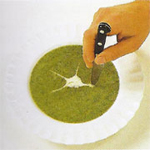
Star Put a spoonful of cream in me center. Draw the tip of a knife
from the center oward the edge of the up to make 5 points.
|
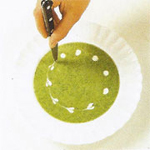
Ring of hearts Drip cream from the tip of a teaspoon to form a
circle of drops. Draw the tip of a small knife through the center of each drop.
|
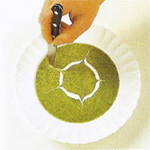
Flower Drizzle cream from the tip of a teaspoon to make a circle.
Draw the tip of a knife through it outward, then inward.
|
|
|
PUREEING SOUPS
Soups are often pureed to give a velvety texture. Starchy vegetables or flour helps
thicken them.
Blender or food processor Either of these can be used to process the cooked ingredients
in batches. Scrape the sides to ensure there are no solid pieces left unprocessed.
Hand blender Use this to puree directly in the saucepan, but only for small quantities
of soup. It is ideal for blending in a final addition of cream.
Strainer Work soup through a fine strainer with a wooden spoon. If soup has been
pureed in a blender, it can then be strained to make it smoother or to remove any
fibers, seeds, or skins.
SKIMMING SOUPS
As a soup is brought to the boil, foam or scum may form on the surface. This is
most likely with soups that contain meat or poultry, particularly on the bone, or
root vegetables and legumes. This foam, which contains impurities, should be removed
as it forms.
Use a large metal spoon or skimmer (slotted if there are herbs and whole spices
in the soup) to skim off foam.
If there is a lot of fat on the surface ofa soup, skim it off with a large metal
spoon or blot it with paper towels before serving.
|











